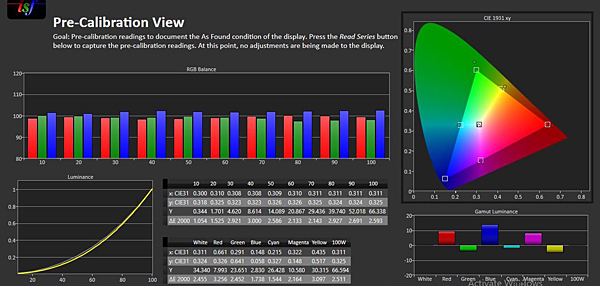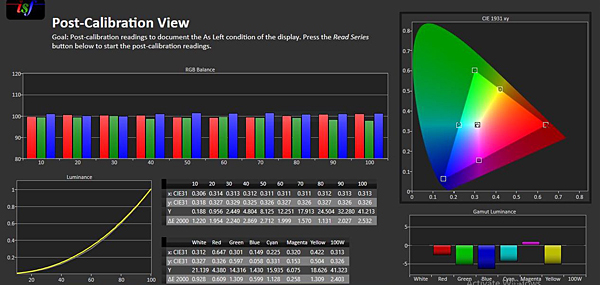Sony XR-65A80J OLED Ultra HDTV Review Test Bench
The measurements here were made using Calman software from Portrait Displays (portrait.com), together with Photo Research PR-650 and Klein K-10A color meters and a Fresco Six-G test pattern generator from Murideo/AVPro.


HD/SDR
Full-On/Full-Off Contrast Ratio: unmeasurable
In the Cinema Picture Mode, with the Black level control at 50, Brightness at Max, Contrast at 90, Peak luminance at Medium, Gamma at 0, peak brightness on a 10% full white window measured 66 Foot-Lamberts (226 nits). Since that level proved uncomfortably bright in a fully darkened room, for the calibration I dropped the Contrast setting down 70, resulting in a brightness level of 44 ft-L (151 nits). The pre-and post-calibration numbers below reflect those different settings.
In the Cinema picture mode and Expert 1 Color temperature setting, the pre-calibration grayscale (white balance) Delta E values ranged from a minimum of 1.53 at 20% to a maximum of 3.0 at 40%. (Delta E is a figure of merit indicating how close the color comes to the D65 color point standard at each point in the brightness range. Values below 3—some experts allow for 4—are generally considered visually indistinguishable from zero.)
The post-calibration results, using only the 2-point Adv. color temperature adjustments resulted in a maximum grayscale Delta E of 2.8 at both 40% and 50%, and a minimum of 1.1 at 70%. Before calibration, the color Delta Es at 75% luminance varied from a minimum of 1.54 in cyan to a maximum of 3.26 in red. Post calibration the minimum was 0.28 in green and the maximum 0.94 in red. With the Gamma control set to zero, the Sony's gamma, both before and after calibration, was 2.2 and adhered to the BT.1886 standard for SDR sources.
Ultra HD/HDR10
Full-On/Full-Off Contrast Ratio: 212,500:1
In the Cinema HDR Picture Mode with the Black level control at 50, Brightness at Max, Contrast at 95, Gamma at 0, Peak luminance at High, the measured peak white level on a 10% white window was 510-515 nits (510 nits = 149 ft-L) and the black level (an average of 10 readings) was 0.0024 nits (0.0007 ft-L).
Following an HDR calibration (using Sony's auto conversion of the SDR calibrated settings to HDR—HDR10 results shown here) the maximum grayscale Delta E was 2.7 at 90% (with no other values higher than 2.1), and the minimum 0.8 at both 20% and 30%. Its maximum color Delta E value at 50% luminance was 3.3 in green and the minimum 0.8 in yellow. At a Contrast setting of 95, the Sony closely followed the HDR PQ curve. In the Contrast setting's default (Max), the brightness was a bit higher (though not significantly) than the PQ standard.
Post calibration saturation sweeps of DCI-P3 (the widest color gamut available from any of today's consumer sources) were good, with color Delta Es never above 3.0 for most of the range (measured at five levels from 20% to 100% saturation), and most of them below 2.0. A Color Checker run (testing dozens of real-world colors) produced Delta E averages of 2.02 (4.22 peak) with luminance included and 1.58 (4.28 peak) without including luminance errors.
As with all HDTVs, but particularly OLEDs, the peak white output varies with how much of the screen is producing a peak white image, particularly in HD. In Cinema mode, a 2% full white window on the 65A80J produced 470 nits, a 10% window 515 nits, a 25% window 350 nits, and a 100% window 150 nits. In Custom mode this increased to 580 nits on a 5% window but was little changed at other window sizes. The default Standard mode did reach 695 nits at 5% and 630 nits at 10%, but at control settings producing significant limitations for an accurate calibration.
Using the Leo Bodnar test device (1080p) to check input lag, the Sony measured 167ms in Cinema picture mode (rechecked several times—not a typo!) and 16ms in Game mode. This was the widest lag range I've yet seen between picture modes on a TV. (It's possible that much of Cognitive work performed by the new XR processor adds significant lag and is therefore turned off in Game mode.)
Using the 1976 standards, the Sony A80J measured 70% of BT.2020 and 96% of DCI-P3 color.
The Sony's 1080i-to-1080p upconversion produced subtle interference on test patterns. This disappeared when similar processing was performed by a Oppo UDP-203 player, my standard-setter for a passing grade on upconversion tests.—TJN



























































